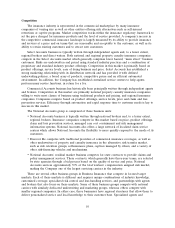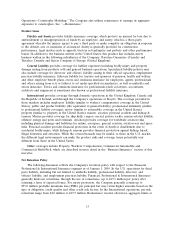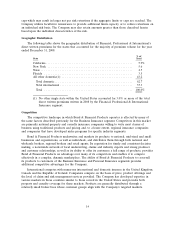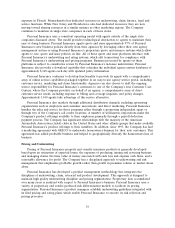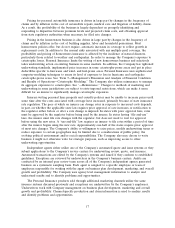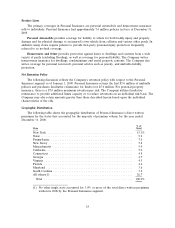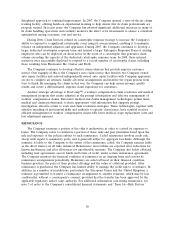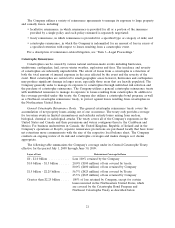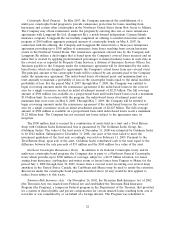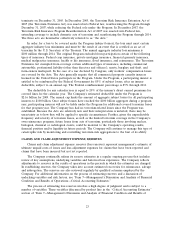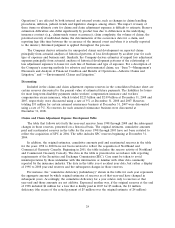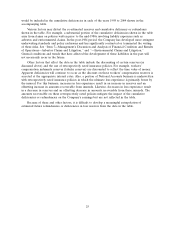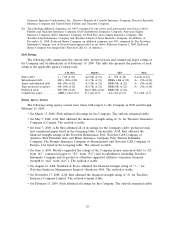Travelers 2008 Annual Report Download - page 31
Download and view the complete annual report
Please find page 31 of the 2008 Travelers annual report below. You can navigate through the pages in the report by either clicking on the pages listed below, or by using the keyword search tool below to find specific information within the annual report.Competition
Personal lines insurance is written by hundreds of insurance companies of varying sizes. Although
national companies write the majority of the business, Personal Insurance also faces competition from
local and regional companies. Personal Insurance primarily competes based on service, ease of doing
business, price, perceived stability of the insurer and name recognition. Personal Insurance competes
for business within each independent agency since these agencies also offer policies of competing
companies. At the agency level, competition is primarily based on the level of service, including claims
handling, as well as the level of automation and the development of long-term relationships with
individual agents, as well as on price. Personal Insurance also competes with insurance companies that
use exclusive agents or salaried employees to sell their products, as well as those that employ direct
marketing strategies, including the use of toll-free numbers and the internet. In addition to its
traditional independent agency distribution, Personal Insurance has broadened its distribution of
products by marketing to sponsoring organizations, including employee and affinity groups, through
joint marketing arrangements with other insurers and direct marketing. Personal Insurance believes that
its continued focus on underwriting and pricing segmentation, claim settlement effectiveness strategies
and expense management practices enable Personal Insurance to price its products competitively in all
of its distribution channels.
CLAIMS MANAGEMENT
The Company’s claims function is managed through its Claim Services operations. With nearly
13,000 employees, Claim Services employs a diverse group of professionals, including claim adjusters,
appraisers, attorneys, investigators, engineers, accountants, system specialists and training, management
and support personnel. Approved external service providers, such as independent adjusters and
appraisers, investigators and attorneys, are available for use as appropriate.
Field claim management teams located in 27 claim centers and 87 satellite and specialty-only
offices in 46 states are organized to maintain focus on the specific claim characteristics unique to the
businesses within the Business Insurance, Financial, Professional & International Insurance, and
Personal Insurance segments. Claim teams with specialized skills, resources, and workflows are matched
to the unique exposures of those businesses with local claims management dedicated to achieving
optimal results within each segment. The Company’s home office operations provide additional support
in the form of workflow design, quality management, information technology, advanced management
information and data analysis, training, financial reporting and control, and human resources strategy.
This structure permits the Company to maintain the economies of scale of a larger, established
company while retaining the agility to respond promptly to the needs of customers, brokers, agents and
underwriters. Claims management for International is generally provided locally by staff in the
respective international location due to local knowledge of applicable laws and regulations.
An integral part of the Company’s strategy to benefit customers and shareholders is its continuing
industry leadership in the fight against insurance fraud through its Investigative Services unit. The
Company has a nationwide staff of experts that investigate a wide array of insurance fraud schemes
using in-house forensic resources and other technological tools. This staff also has specialized expertise
in fire scene examinations, medical provider fraud schemes and data mining. The Company also
dedicates investigative resources to ensure that violations of law are reported to and prosecuted by law
enforcement agencies.
Claim Services uses advanced technology, management information, and data analysis to assist the
Company in reviewing its claim practices and results to evaluate and improve its claims management
performance. The Company’s claims management strategy is focused on segmentation of claims and
appropriate technical specialization to drive effective claim resolution. The Company continually
monitors its investment in claim resources to maintain an effective focus on claim outcomes and a
19



